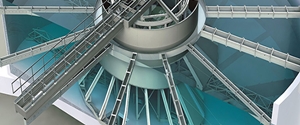Canada to build world’s largest ozonation waste-water treatment centre
25 Mar 2015
Canada's second-biggest city Montreal is going ahead with its plan to construct the world's largest ozonation waste water treatment centre at a total cost of $285 million. 
The plant will be located at the Jean-R-Marcotte water and sewage treatment facilities in Pointe-aux-Trembles at the north eastern part of the city.
When completed in 2018, it will have the capacity to purify 2.6 million cubic litres of water daily, the equivalent of two Olympic stadiums.
The city administration has awarded an initial $99-million construction contract to France's Degremont Technologies, which was the best out of two bids submitted, after a four-year long tendering process.
Degremont will build the ozonation plant that will produce the ozone gas for the treatment of waste-water.
Montreal already uses ozone to treat its drinking water.
According to city officials, the risk of leakage of ozone from the plant was minimal as it will produce only as much as needed on a daily basis and stop production immediately if necessary.
The Jean-R-Marcotte plant treats waste water before it is discharged to the St Lawrence. Currently, the plant uses chemical additives to treat water.
''Ozone treatment will start in 2018 and will significantly improve the quality of waste water restored by the island of Montreal to our majestic St Lawrence river,'' Montreal mayor Denis Coderre said.
''It's a responsible, sustainable choice that will preserve our aquatic ecosystems and improve public health,'' he added.
The decision to use an ozonation system for Montreal's waste-water treatment was taken in 2008 jointly by the city administration and Quebec's environmental and agricultural ministries on the consideration that ozone is a powerful cleaner, disinfectant and bleaching agent most suitable for the city's industry-heavy effluent.
The plant will use ozone to clean water from harmful organisms and cleansing traces of cosmetic and pharmaceutical products and industrial waste.
It is expected to eliminate 95 per cent of bacteria, particularly E.coli, and also get rid of most viruses.
Ozonation does not require other chemical additives to be mixed with water.
The project will be 85-per cent funded by the grants from the federal and provincial governments as part of the infrastructure programme.
The new system will be initially tested during the May to October period, but will be extended later to year-bound running.
However, some researchers are of the opinion that ultraviolet technology is more widely used for waste water treatment and could prove considerably cheaper than ozonation, which has never been used on the scale proposed in Montreal.













.jpg)






.jpg)









